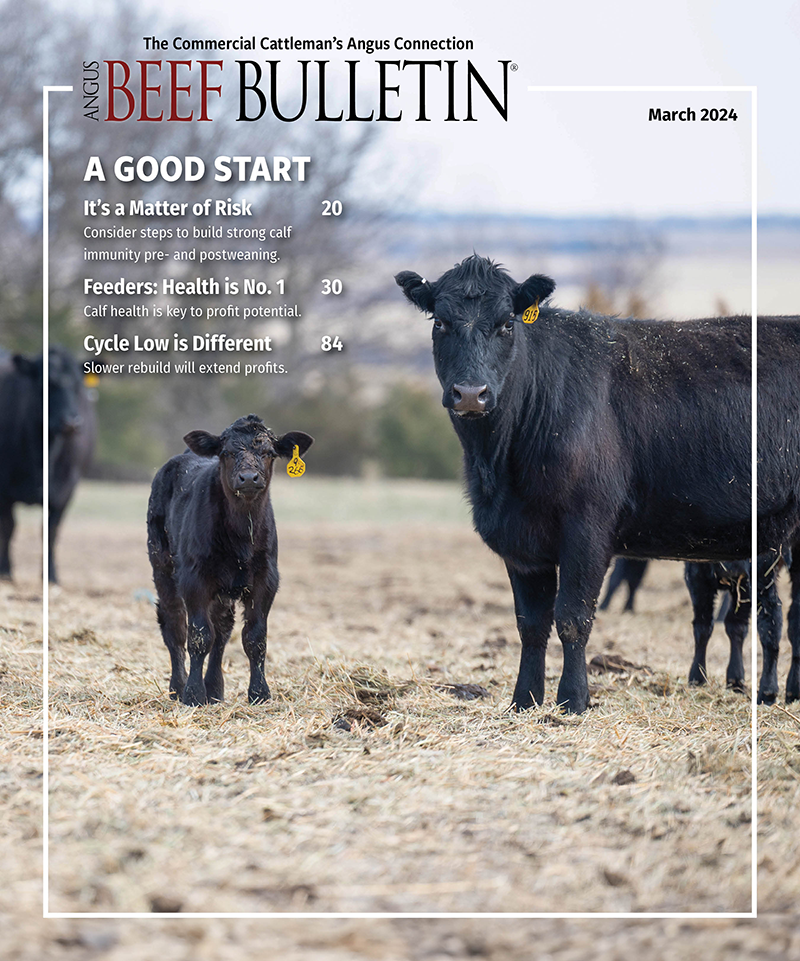
From the Field
As the country transitions from winter to spring, here are some ideas to consider from your Association regional managers.
While very few people would choose chilly weather over green grass and warmer temperatures, the transitional period between winter and spring can be challenging no matter what production phase your herd currently falls within.
How can cattlemen capitalize on the current market and continue managing their herds for the future? We asked American Angus Association regional managers Reese Tuckwiller, Rod Geppert and Kurt Kangas.
Keeping tabs on health
On the East Coast and into New England, calving could either be wrapping up or just beginning. Regardless of where a herd falls in that timeline, spring will have its fair share of challenges. From an adundance of mud to potential forage toxicity, vigilance remains a producer’s best friend.
“One issue we have in our part of the world — mainly West Virginia, Virginia and North Carolina — we deal with a lot of toxic fescue,” says Reese Tuckwiller, regional manager for Region 1, noting that additional protein supplementation could help cows through potentially toxic days. “Whether it’s understanding what the toxic fescue levels are on your operation or making some preventative choices with your mineral program to better manage overall herd health, there’s value there.”
Another concern moving into the spring is early high temperatures before cattle have the opportunity to adequately shed. With conditions reaching 90%-95% humidity and ranging from 80°-100° F in temperature, cattle slow to shed can certainly falter. Identifying cattle that shed effectively and culling cattle that don’t is one way producers can maximize traits valuable to their region and their own operation, suggests Tuckwiller.
Culling for management
With the market still holding strong, now may be the time to make the call when it comes to marketing females that rank below average within your own herd, notes Rodd Geppert, regional manager for Region 6.
“Now is the time to get rid of some of these problem cows. Just ship them, especially if they’re open,” says Geppert. He also encourages producers to ensure the fertility of natural-service sires prior to breeding season and to recognize potential heat stress events, which could influence the percentages of successful pregnancies.
Geppert encourages cattlemen to recogize that heat stress can severely affect semen quality for natural-service sires. Mitigating that risk relies heavily on an animal’s ability to cool itself, as well as providing access to shade and sources of clean water.
Marketability
Coming off Fall 2023 with great forage availability for cattle, producers in Region 10 are shifting their concerns to the price their calves could bring in the summer videos and whether a black-swan event could cause a disruption in the system that would drop those prices, says Kurt Kangas, regional manager for Region 10. The rebuild of the cattle herd to get the inventory back up could also be a challenge.
“The guys that want to feed heifers are competing pretty hard against the guys that want to breed them. Obviously, you take delivery data into account for some of the pricing, but if you look at the prices of the heifer calves that were getting $1,900, now they’re pretty steady at $2,200 to $2,300,” says Kangas. “Does that get better as we go forward? Does it stay the same? It’s hard to say.”
In summary
While many producers might have weeded their herds down, there is still plenty of opportunity available for those willing to capitalize.
“Everybody seems to be in a pretty good mood,” says Geppert. “No one is really complaining about a whole lot other than the input costs and other assorted bills that go along with it. But it seems like there are still opportunities to make money in this business right now for those willing to jump in.”
Editor’s note: “From the Field” is a regular Angus Beef Bulletin EXTRA column featuring advice, industry news and Angus updates from regional managers of the American Angus Association. For information on how to contact your regional manager, please visit https://www.angus.org/assoc/RM. [Lead photo by Shauna Hermel.]



